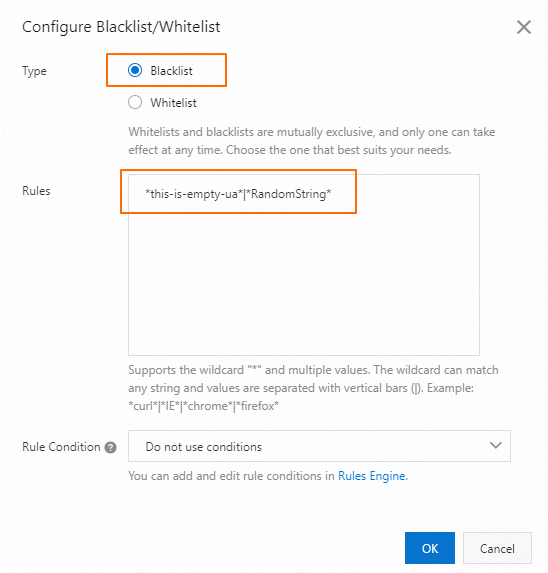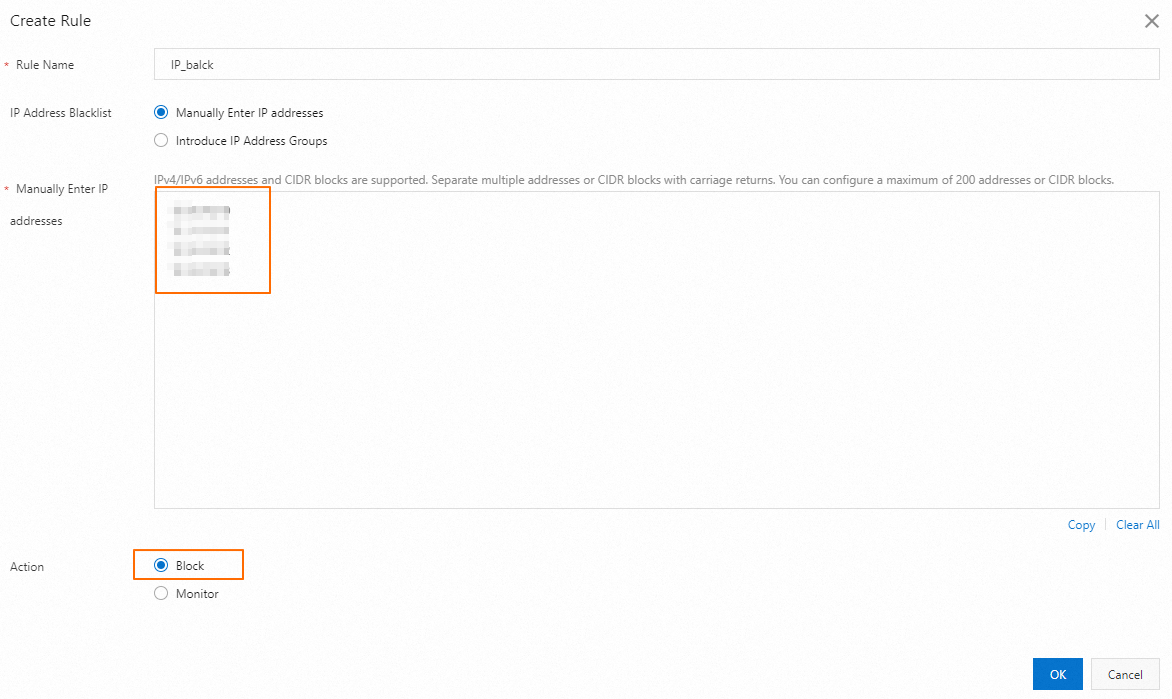If your domain name is attacked or abused for data transmission, high bandwidth consumption or traffic spikes occur. In this case, you receive bills that are higher than expected. High bills that are generated by malicious attacks or data transmission abuse cannot be waived or refunded. This topic describes how to prevent data transmission abuse.
Minimize losses at the earliest opportunity
If your domain name is attacked or abused for data transmission, and you receive bills that are higher than expected, you need to specify a bandwidth cap and configure traffic throttling for individual requests to reduce further losses. Then, you can analyze the logs and configure security settings accordingly.
Limit bandwidth usage
Limit the downstream speed
Troubleshooting
Query billing details to locate the time period during which traffic is abnormal
You can view the billing details of cloud services on the Billing Details tab. Select a statistical dimension and a statistical period to view reports based on different dimensions. For more information, see Billing details.
Select CDN from the Product drop-down list, set Statistic Period to Billing Period, review the bills, and pay attention to the abnormal increase in traffic and bandwidth, and the time period during which traffic is abnormal. For more information, see Query bills.
Check logs to identify abnormal traffic
Basic query: offline logs
You can download offline logs to view the access logs of the relevant time period, analyze the details of HTTP requests, and identify suspicious IP addresses and User-Agent headers. Offline logs contain a small number of fields. If you want to view more detailed data, you can use the real-time logs feature.
After you obtain offline logs, you can use command-line interfaces (CLIs) to parse logs and extract information such as the top 10 IP addresses or User-Agent headers. For more information, see Analysis Method of Alibaba Cloud Content Delivery Network Access Log.
Advanced query: operations reports and real-time logs
You need to create a custom operations report to generate statistical data for analysis. If you have configured real-time log delivery or subscribed to operations reports, you can view logs of the corresponding periods. The operations report feature is provided by Alibaba Cloud CDN and is free of charge.
You need to activate Simple Log Service (SLS) and deliver logs before real-time logs are generated. Real-time logs is a paid feature. For more information, see Billing rules.
You need to configure real-time logs and operations reports before you can use real-time logs and operations report for troubleshooting. Otherwise, you can use only offline logs to analyze historical data.
Solutions
After you obtain logs or report data, you can analyze the attack types based on data features. In most cases, you can analyze the top information, such as top IP addresses, top User-Agent headers, and top Referer headers, to extract features.
Restrict access from suspicious IP addresses
You can configure an IP address blacklist to restrict access from specific IP addresses. After you analyze the logs and identify some suspicious attack IP addresses, you need to add the IP addresses to the blacklist. For more information, see Configure an IP address blacklist or whitelist.

Filter suspicious User-Agent headers
Attackers attempt to bypass security checks by using forged User-Agent headers to send a large number of requests. A forged User-Agent header may be a null value, a random string, or a forged string for common browsers. You can configure a User-Agent whitelist or blacklist to reject requests that contain an abnormal User-Agent header. For example, you can use the this-is-empty-ua and RandomString parameters to reject User-Agent headers that are empty or contain invalid random strings. For more information, see Configure a User-Agent blacklist or whitelist.

Add suspicious Referer headers to the blacklist
Attackers forge Referer headers in requests to impersonate legitimate reference sources and initiate malicious requests. You can configure a Referer blacklist or whitelist to allow requests that contain legitimate Referer headers, prevent links to resources from unauthorized third-party websites, and reject requests that contain malicious Referer headers. In the Rules field, enter the abnormal Referer headers that are found from logs. We recommend that you select Ignore Scheme in Advanced Settings. For more information, see Configure a Referer whitelist or blacklist to enable hotlink protection.

Upgrade from Alibaba Cloud CDN to DCDN and enable the WAF feature
We recommend that you upgrade from Alibaba Cloud CDN to Dynamic Content Delivery Network (DCDN) for your domain name and enable the Web Application Firewall (WAF) feature. DCDN provides application acceleration, edge computing, and security protection capabilities. WAF allows you to configure protection rules, such as IP address blacklist and whitelist, rate limiting, bot management, HTTP flood protection, and region blacklist, to block malicious requests and prevent high bills for abnormal traffic.
Upgrade to DCDN for your domain name. For more information, see Upgrade from Alibaba Cloud CDN to DCDN for your domain name. Alibaba Cloud CDN charges the fees that are generated before the upgrade. DCDN charges the fees that are generated after the upgrade.
After you upgrade to DCDN, enable WAF. For more information, see Enable WAF.
Purchase a WAF resource plan. WAF uses security capacity units (SeCUs) as the billing unit and supports the pay-as-you-go and subscription billing methods. For more information, see Billing of WAF (new version).
NoteTo purchase a WAF plan (new version), go to the buy page.
What to do next
Configure real-time monitoring
You can monitor the bandwidth of Alibaba Cloud CDN-accelerated domain names. After the bandwidth of a domain name reaches the specified threshold, you are notified of the potential risks by text message, email, or DingTalk message. For more information, see Configure alert rules.
Configure bill alerts
You can use the following features to monitor and limit the expenses. To configure the features, move your pointer over Expenses in the top navigation bar of the console and select Expenses and Costs.
High bill alerts: If you enable this feature, the system sends an alert by text message when a daily bill exceeds the alert threshold that you specified.
Service suspension protection: If you disable this feature, the service immediately stops running after a payment becomes overdue to prevent high overdue payments.
High bill alert: After this feature is enabled, notifications are sent to you by text message if a daily bill reaches a specified amount.
To ensure the integrity of the statistics and the accuracy of bills, Alibaba Cloud CDN issues the bill approximately 3 hours after a billing cycle ends. The point in time at which the relevant fees are deducted from your account balance may be later than the point in time at which the resources are consumed within the billing cycle. Alibaba Cloud CDN is a distributed service. Therefore, Alibaba Cloud does not provide the consumption details of resources in bills. Other CDN providers use a similar approach.









